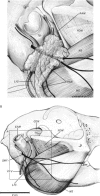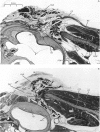Abstract
In the rabbit, jaw opening and closing occurs in combination with condylar protrusion and retraction. Consequently the centre of rotation (CR) for the movement lies in the inferior portion of the ascending ramus of the mandible, far below the condyle. This location is stable and independent of the type of food being chewed and the age of the animal. The topography of the soft tissues at the posterior border of the ramus is adapted to the movement pattern. The facial nerve crosses the space between skull and mandible at the level of the CR. The parotid gland lies behind the ramus between condyle and CR; below the CR, the gland is replaced by loose adipose tissue. A computer model was used to demonstrate that the location of the CR determines the amount of stretch of the large masseter and medial pterygoid muscles. Using parameters for passive elastic behaviour of muscle, obtained by postmortem measurements, it can be shown that the normal CR position minimises muscle stretch and passive elastic forces. Even a small upward displacement of the CR causes a significant amount of resistance in the jaw-closers at gapes comparable to those reached in natural mastication. A second, less dramatic effect of increased muscle stretch is a sharper decline of maximum possible active closing force, due to the interrelationship of fibre length and isometric tension. In young animals, the muscle fibres are relatively long but stiff; in adults they are shorter, but more compliant. In both ages the CR is located in such a way that masseter and medial pterygoid stretching is minimised. The high position of the temporomandibular joint ensures a maximal leverage for the muscles mentioned above. By separating the point where the reaction forces apply (the joint) from the location of the rotational axis, maximum leverage and minimal length changes of the jaw-closing muscles are achieved simultaneously. It is further suggested that elastic muscular forces play a role in determining the position of the CR.
Full text
PDF
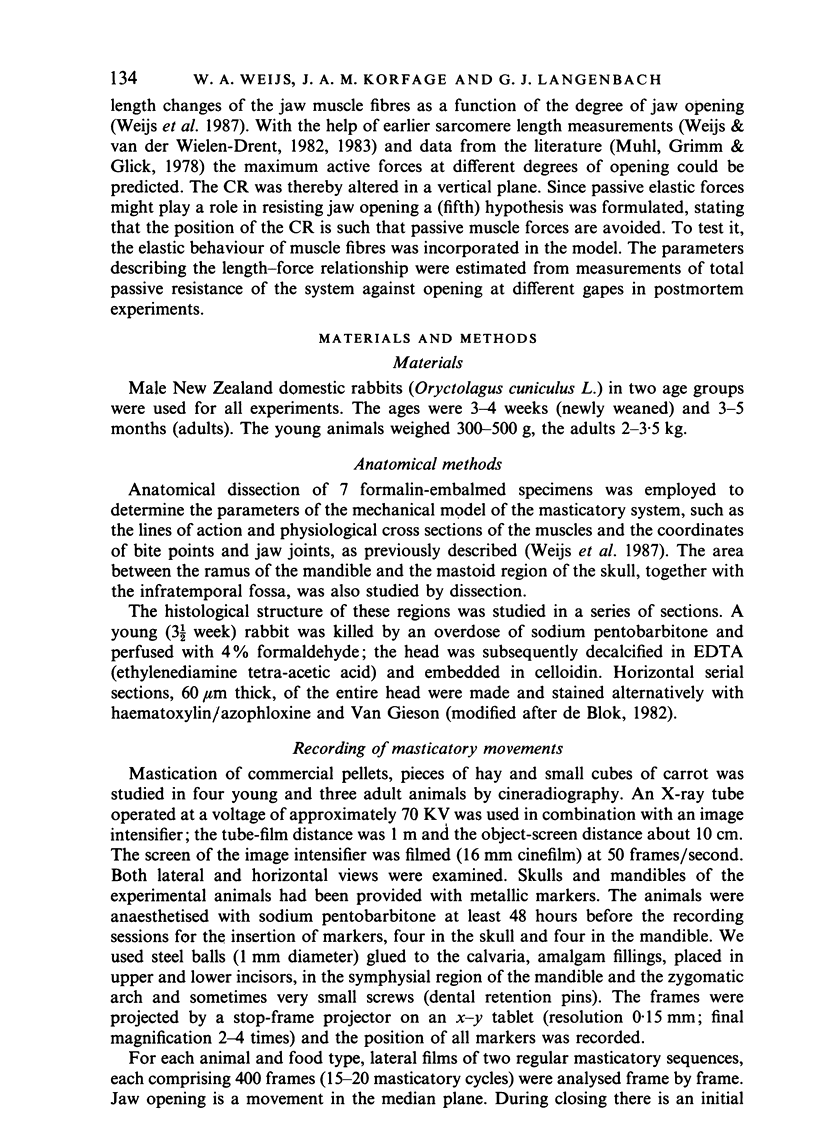
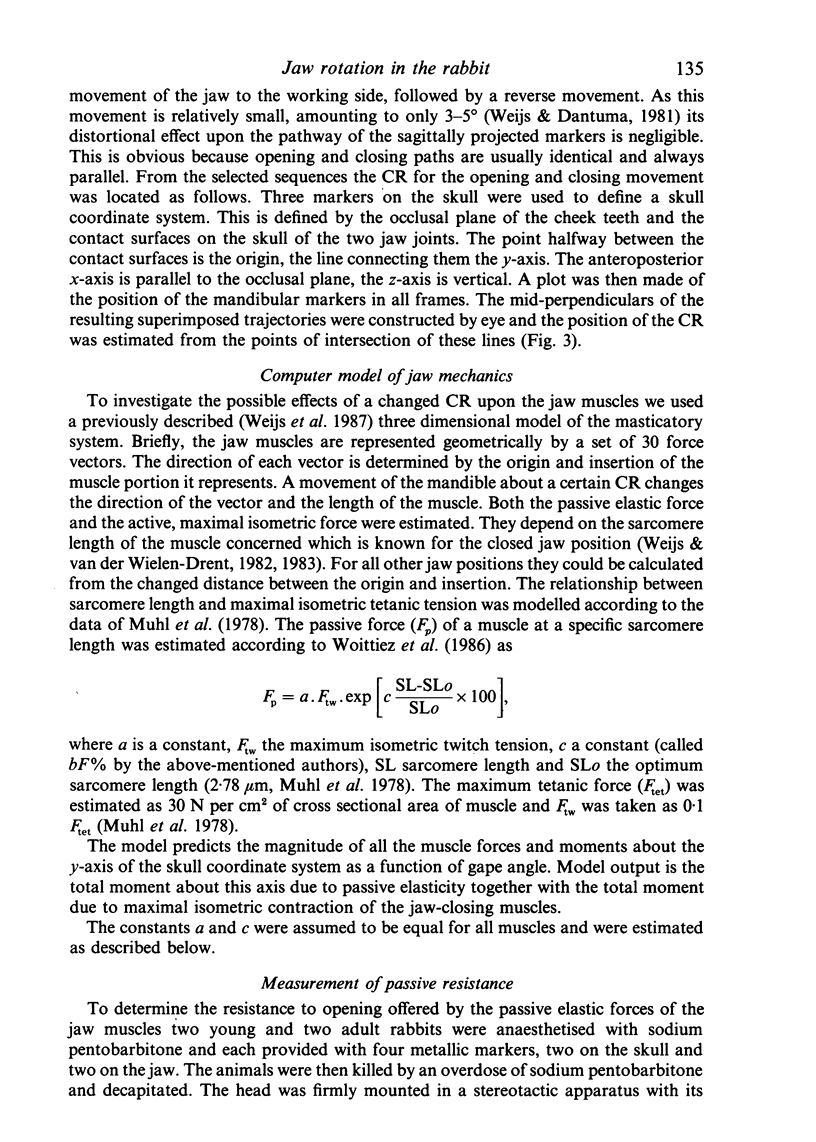


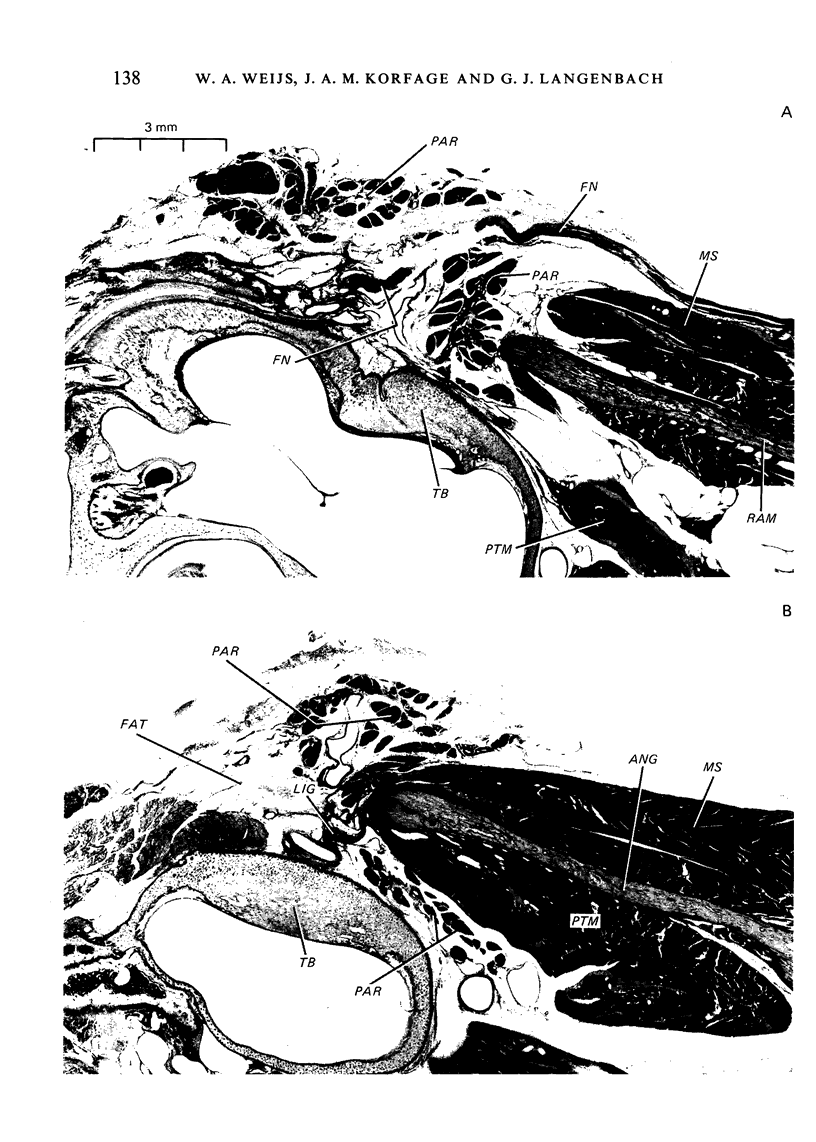
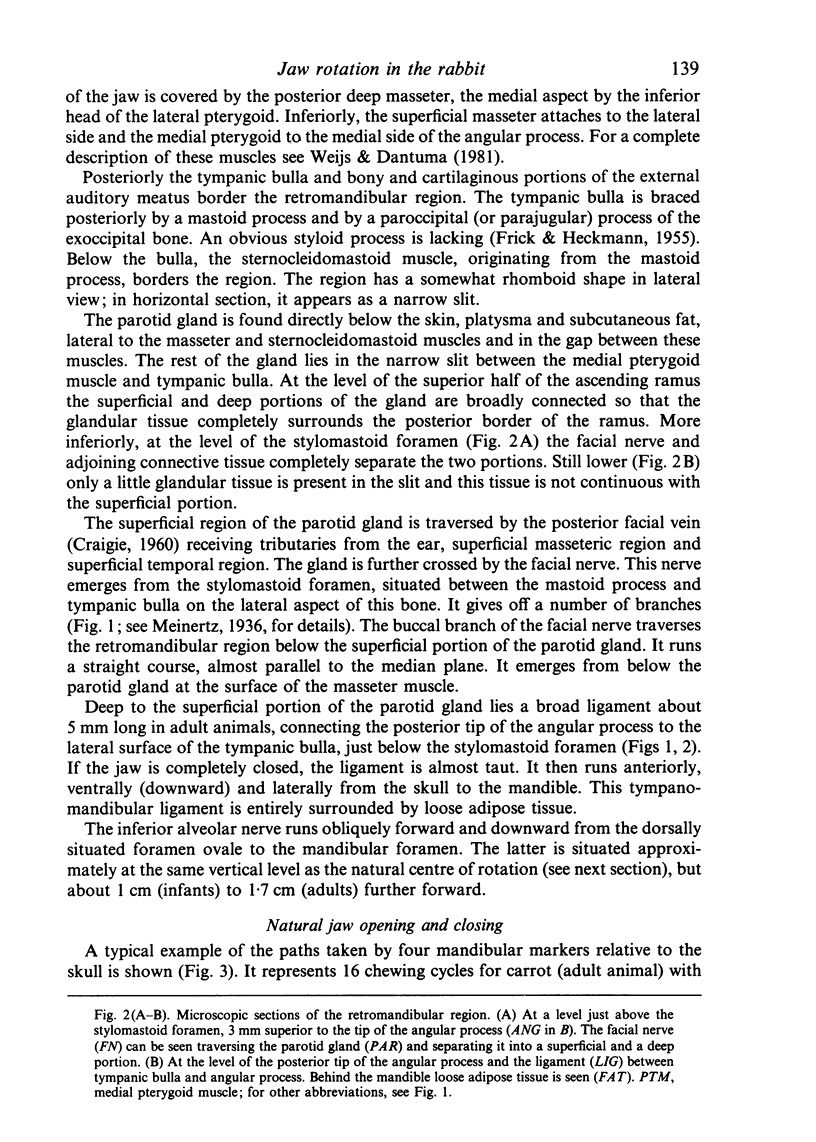
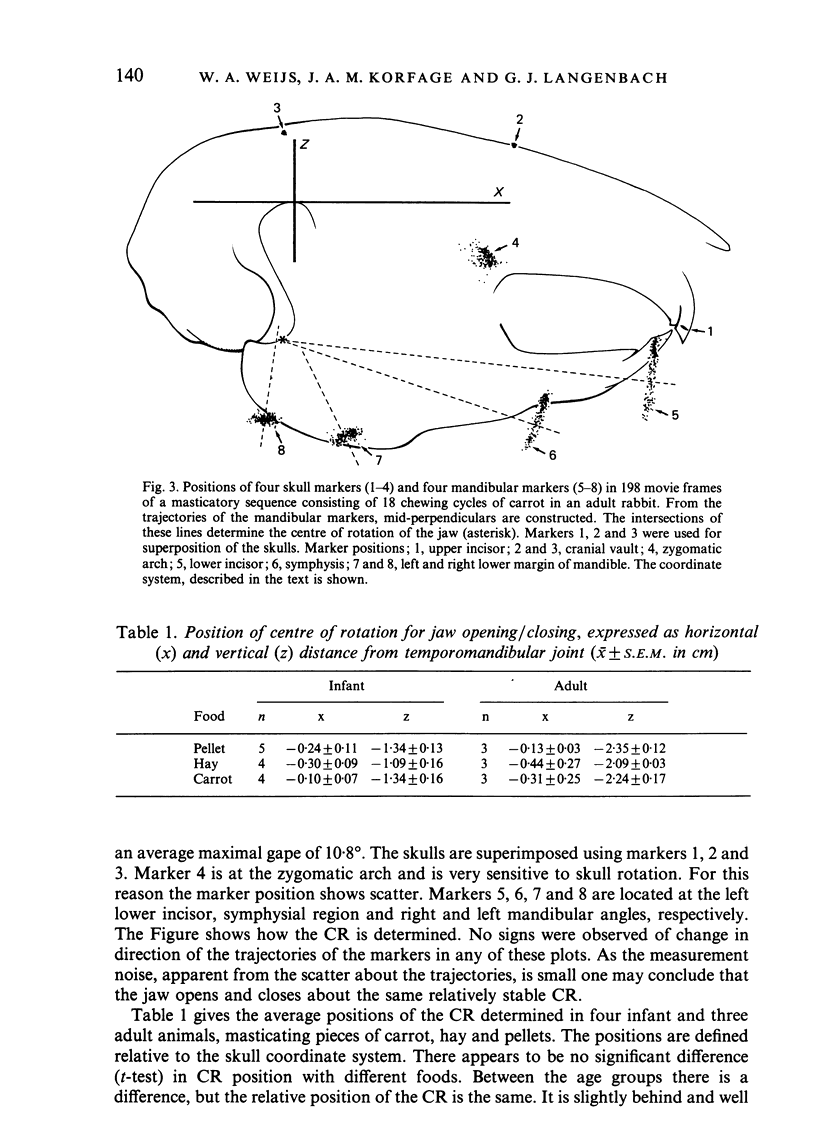
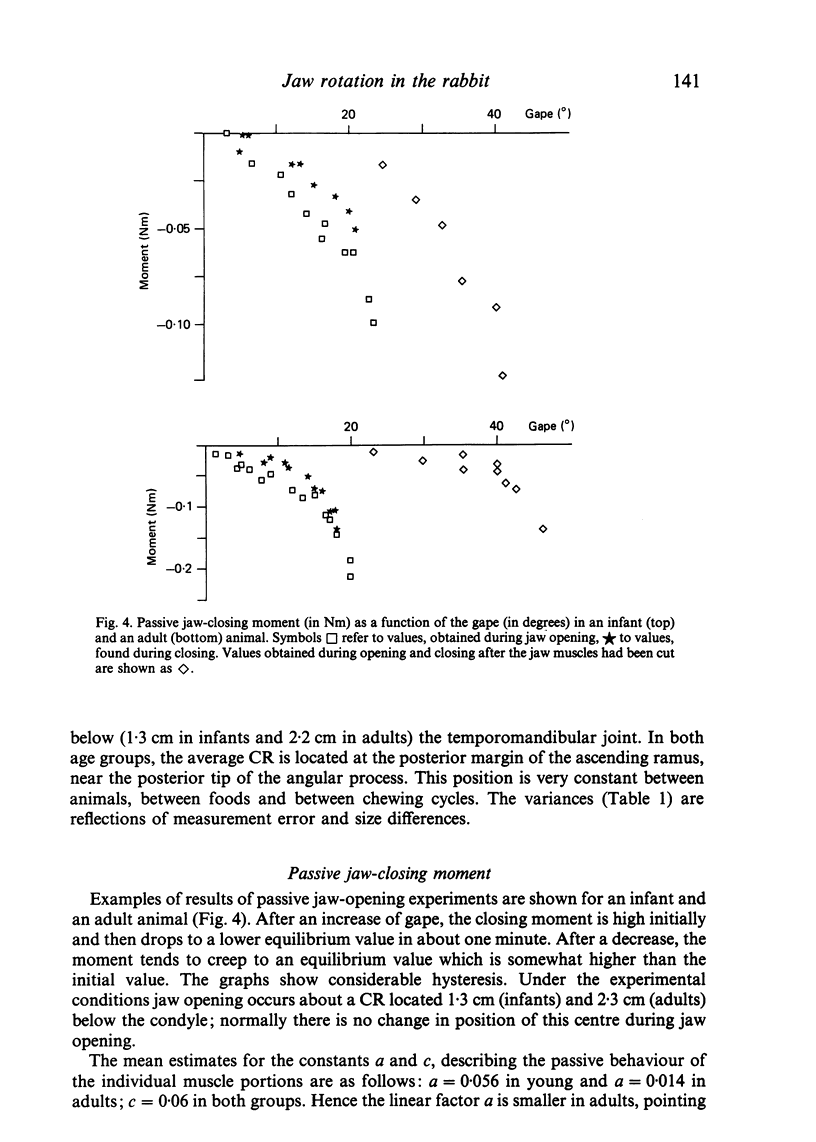
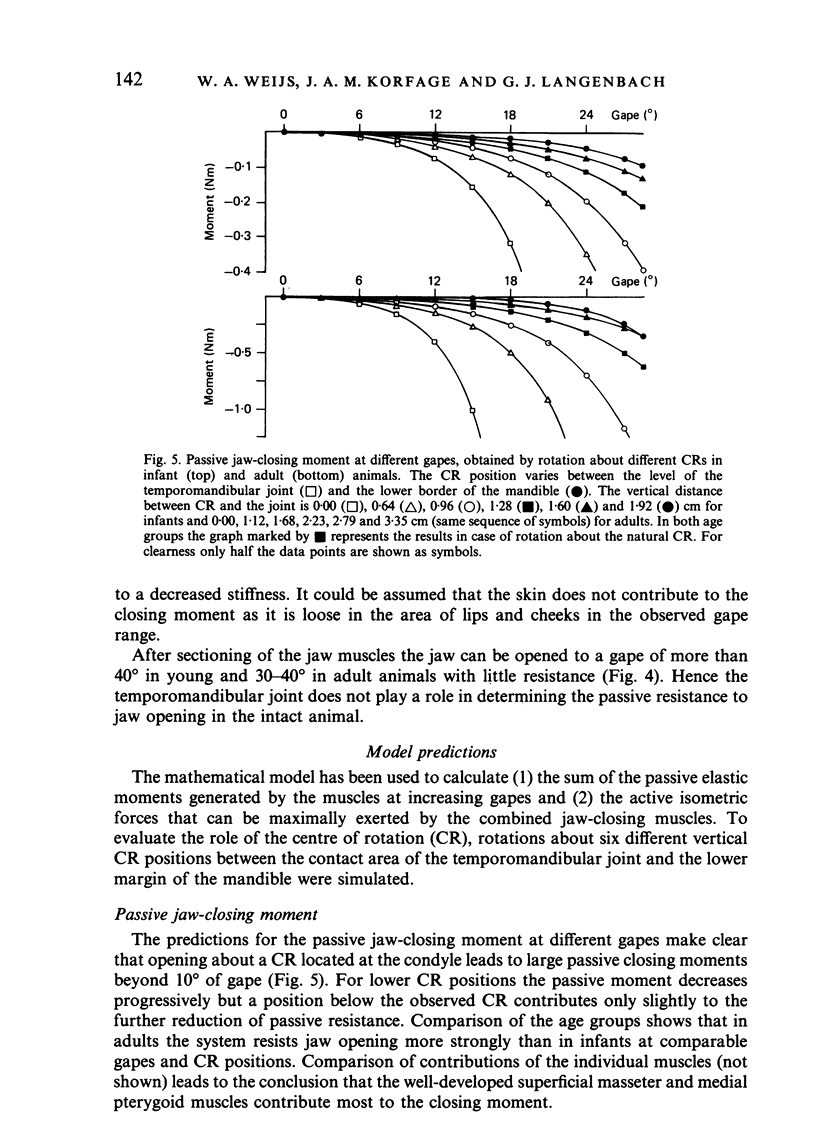
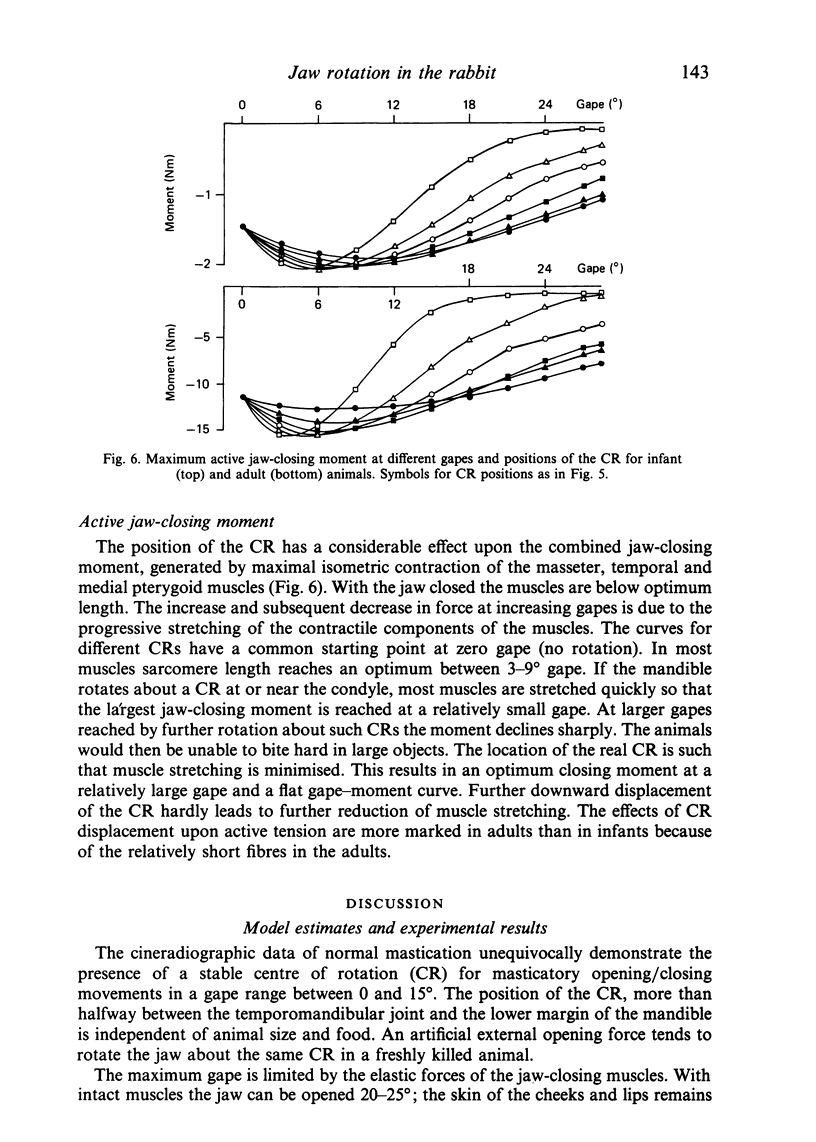
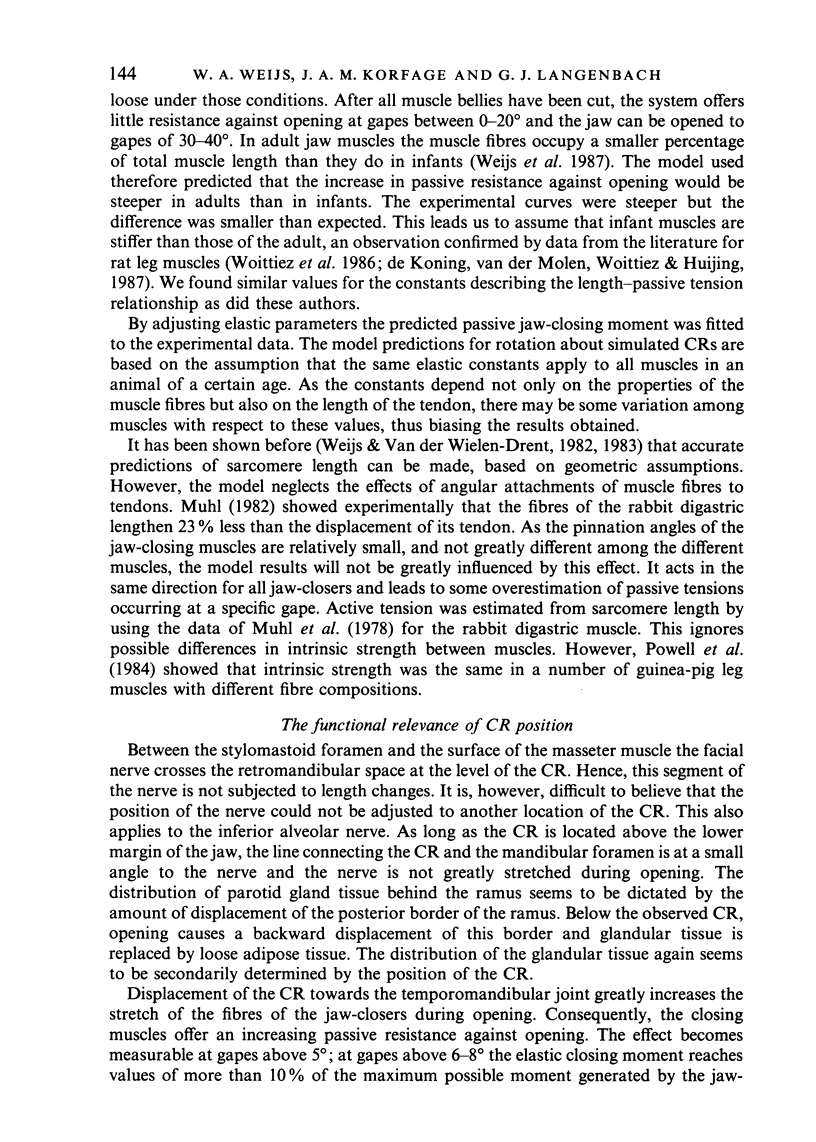
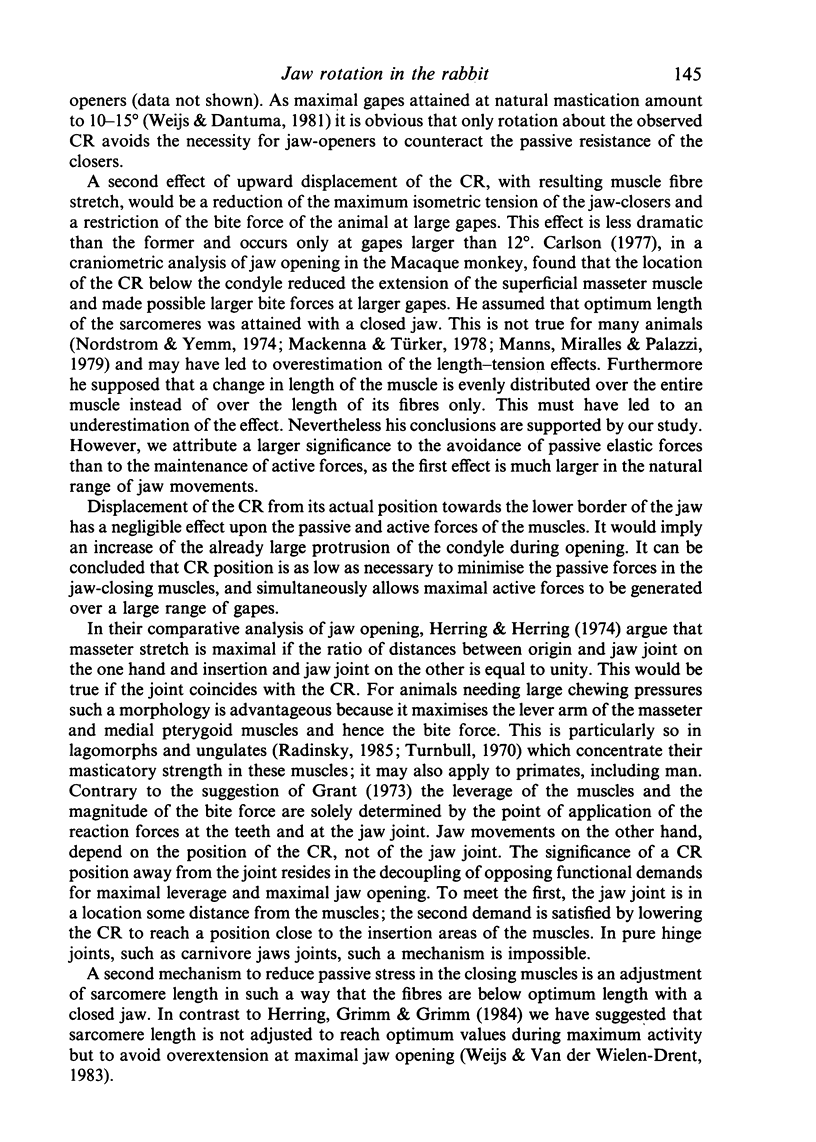
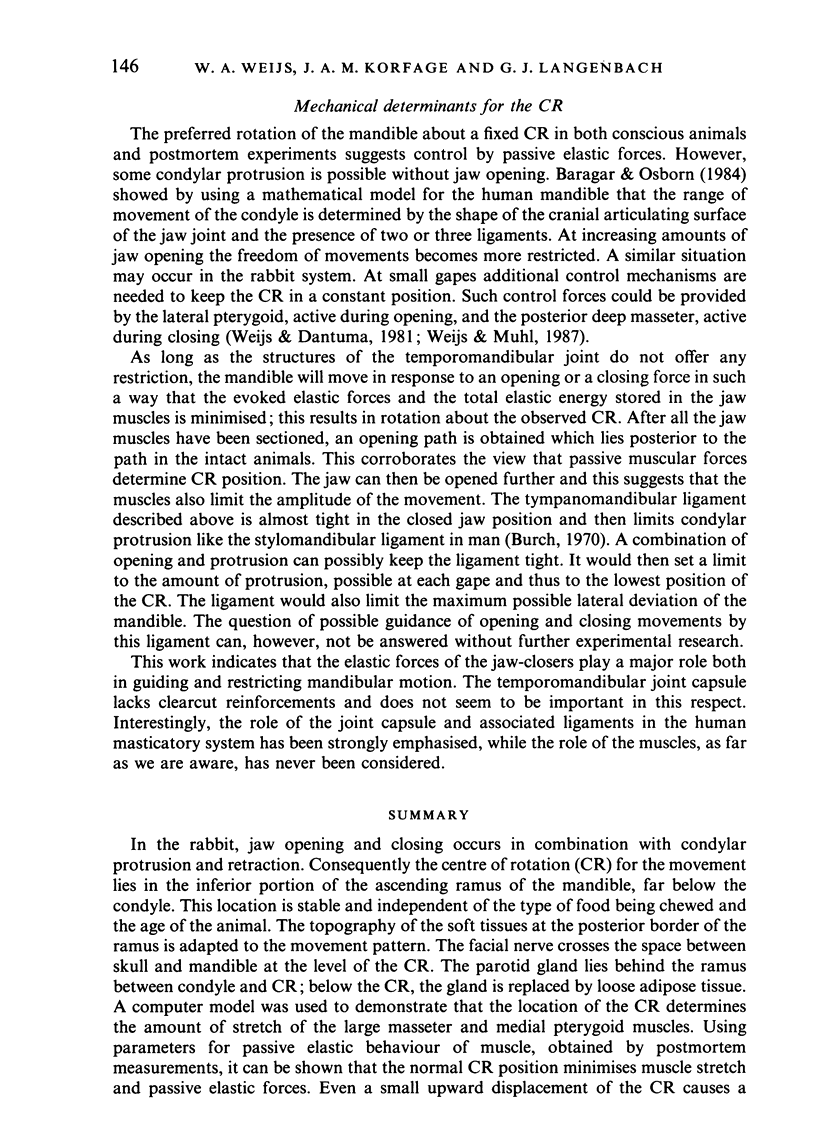
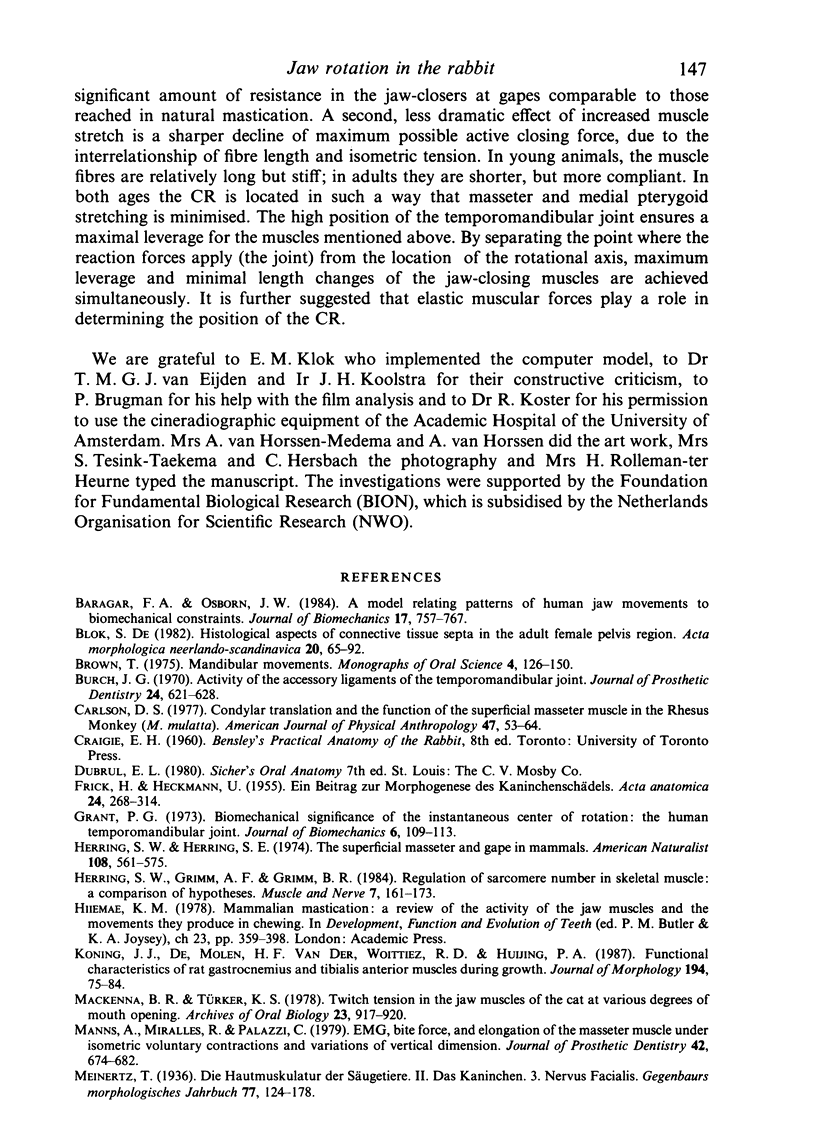
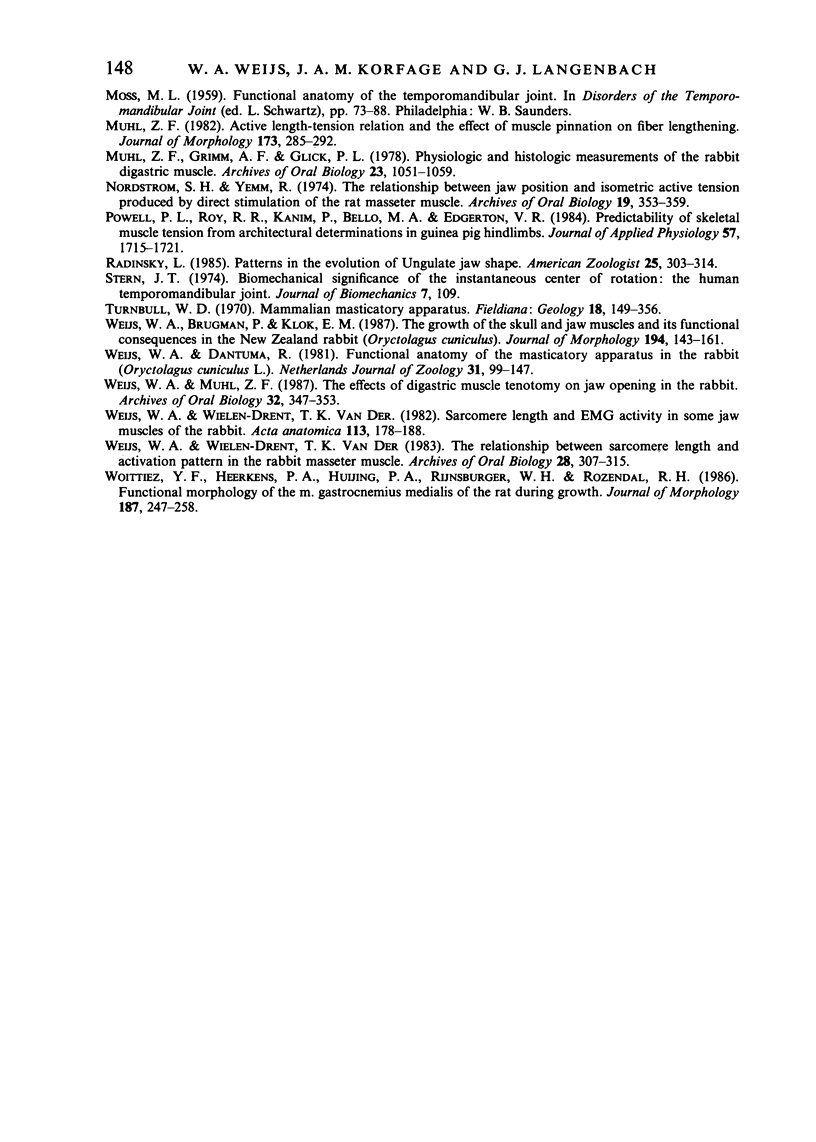
Images in this article
Selected References
These references are in PubMed. This may not be the complete list of references from this article.
- Baragar F. A., Osborn J. W. A model relating patterns of human jaw movement to biomechanical constraints. J Biomech. 1984;17(10):757–767. doi: 10.1016/0021-9290(84)90106-4. [DOI] [PubMed] [Google Scholar]
- Brown T. Mandibular movements. Monogr Oral Sci. 1975;4:126–150. doi: 10.1159/000397870. [DOI] [PubMed] [Google Scholar]
- Burch J. G. Activity of the accessory ligaments of the temporomandibular joint. J Prosthet Dent. 1970 Dec;24(6):621–628. doi: 10.1016/0022-3913(70)90098-3. [DOI] [PubMed] [Google Scholar]
- Carlson D. S. Condylar translation and the function of the superficial masseter muscle in the rhesus monkey (M. mulatta). Am J Phys Anthropol. 1977 Jul;47(1):53–63. doi: 10.1002/ajpa.1330470111. [DOI] [PubMed] [Google Scholar]
- De Koning J. J., van der Molen H. F., Woittiez R. D., Huijing P. A. Functional characteristics of rat gastrocnemius and tibialis anterior muscles during growth. J Morphol. 1987 Oct;194(1):75–84. doi: 10.1002/jmor.1051940107. [DOI] [PubMed] [Google Scholar]
- FRICK H., HECKMANN U. Ein Beitrag zur Morphogenese des Kaninchenschädels. Acta Anat (Basel) 1955;24(3-4):268–314. [PubMed] [Google Scholar]
- Grant P. G. Biomechanical significance of the instantaneous center of rotation: the human temporomandibular joint. J Biomech. 1973 Mar;6(2):109–113. doi: 10.1016/0021-9290(73)90080-8. [DOI] [PubMed] [Google Scholar]
- Herring S. W., Grimm A. F., Grimm B. R. Regulation of sarcomere number in skeletal muscle: a comparison of hypotheses. Muscle Nerve. 1984 Feb;7(2):161–173. doi: 10.1002/mus.880070213. [DOI] [PubMed] [Google Scholar]
- Mackenna B. R., Türker K. S. Twitch tension in the jaw muscles of the cat at various degrees of mouth opening. Arch Oral Biol. 1978;23(10):917–920. doi: 10.1016/0003-9969(78)90297-2. [DOI] [PubMed] [Google Scholar]
- Manns A., Miralles R., Palazzi C. EMG, bite force, and elongation of the masseter muscle under isometric voluntary contractions and variations of vertical dimension. J Prosthet Dent. 1979 Dec;42(6):674–682. doi: 10.1016/0022-3913(79)90200-2. [DOI] [PubMed] [Google Scholar]
- Muhl Z. F. Active length-tension relation and the effect of muscle pinnation on fiber lengthening. J Morphol. 1982 Sep;173(3):285–292. doi: 10.1002/jmor.1051730305. [DOI] [PubMed] [Google Scholar]
- Muhl Z. F., Grimm A. F., Glick P. L. Physiologic and histologic measurements of the rabbit digastric muscle. Arch Oral Biol. 1978;23(12):1051–1059. doi: 10.1016/0003-9969(78)90108-5. [DOI] [PubMed] [Google Scholar]
- Nordstrom S. H., Yemm R. The relationship between jaw position and isometric active tension produced by direct stimulation of the rat masseter muscle. Arch Oral Biol. 1974 May;19(5):353–359. doi: 10.1016/0003-9969(74)90176-9. [DOI] [PubMed] [Google Scholar]
- Powell P. L., Roy R. R., Kanim P., Bello M. A., Edgerton V. R. Predictability of skeletal muscle tension from architectural determinations in guinea pig hindlimbs. J Appl Physiol Respir Environ Exerc Physiol. 1984 Dec;57(6):1715–1721. doi: 10.1152/jappl.1984.57.6.1715. [DOI] [PubMed] [Google Scholar]
- Stern J. T., Jr Letter: Biomechanical significance of the instantaneous center of rotation: the human temporomandibular joint. J Biomech. 1974 Jan;7(1):109–110. doi: 10.1016/0021-9290(74)90075-x. [DOI] [PubMed] [Google Scholar]
- Weijs W. A., Brugman P., Klok E. M. The growth of the skull and jaw muscles and its functional consequences in the New Zealand rabbit (Oryctolagus cuniculus). J Morphol. 1987 Nov;194(2):143–161. doi: 10.1002/jmor.1051940204. [DOI] [PubMed] [Google Scholar]
- Weijs W. A., Muhl Z. F. The effects of digastric muscle tenotomy on jaw opening in the rabbit. Arch Oral Biol. 1987;32(5):347–353. doi: 10.1016/0003-9969(87)90090-2. [DOI] [PubMed] [Google Scholar]
- Weijs W. A., van der Wielen-Drent T. K. Sarcomere length and EMG activity in some jaw muscles of the rabbit. Acta Anat (Basel) 1982;113(2):178–188. doi: 10.1159/000145553. [DOI] [PubMed] [Google Scholar]
- Weijs W. A., van der Wielen-Drent T. K. The relationship between sarcomere length and activation pattern in the rabbit masseter muscle. Arch Oral Biol. 1983;28(4):307–315. doi: 10.1016/0003-9969(83)90073-0. [DOI] [PubMed] [Google Scholar]
- Woittiez R. D., Heerkens Y. F., Huijing P. A., Rijnsburger W. H., Rozendal R. H. Functional morphology of the M. gastrocnemius medialis of the rat during growth. J Morphol. 1986 Feb;187(2):247–258. doi: 10.1002/jmor.1051870210. [DOI] [PubMed] [Google Scholar]



